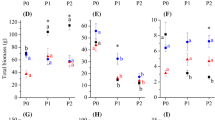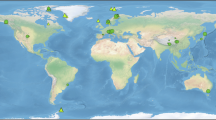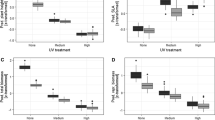Abstract
Understanding the geographic patterns of reproductive allocation helps in clarifying the selective forces that shape the reproductive strategies of plants. However, studies on the elevational patterns of reproductive allocation remain limited. Moreover, although soil attributes have long been suspected to drive elevational patterns of reproductive allocation, few studies have explored this relationship. Delaying reproduction and allocating a high proportion of biomass to vegetative organs may be risky for plants living under high-elevation habitats, as these two processes can potentially lead to plant reproductive failure due to the low temperatures and short growing seasons at high elevations. Thus, we hypothesize that reproductive effort will increase with elevation and the elevational pattern of reproductive allocation will be largely driven by soil attributes, given their covariation with elevation. To test these hypotheses, we determined the vegetative and reproductive biomass of individual Impatiens arguta (Balsaminaceae) plants across 12 populations in the Gaoligong Mountains (China), and collected data on soil temperature, nutrients, moisture, and pH for each population. Based on standard major axis regression and linear regression models, we found that (1) both vegetative and reproductive biomass decreased with elevation; (2) all populations demonstrated significant allometric slopes (i.e., linear coefficients of log[reproductive biomass] − log[vegetative biomass] regressions) > 1; (3) allometric slopes decreased with elevation; and (4) soil temperature was a better predictor of the allometric slope than elevation, i.e., the allometric slope decreased with soil temperature. These results suggest that plant species growing at high elevation invest proportionately more resources to reproduction as an adaptation to low-temperature environments, and reproductive output is heavily dependent on vegetative growth. This study provides the first evidence of soil temperature driving reproductive allocation patterns, which suggests that plant species will favor allocation to growth under increasing soil temperatures with climate warming.





Similar content being viewed by others
Data availability
Supporting data will be uploaded to the Dryad Digital Repository upon acceptance.
References
Akiyama S, Ohba H, Wu SK (1996) Distribution of Impatiens in Yunnan with notes on distribution pattern of Himalayan elements in Yunnan, SW China. Bull Natl Sci Mus 21:151–168
Babin CH, Howard JJ (2019) Does plant allometry predict biased sex allocation in Triadica sebifera (L.) small (Euphorbiaceae)? Plant Ecol 220:529–539
Cai J, Zhang Y, Li Y, Liang XS, Jiang T (2017) Analyzing the characteristics of soil moisture using GLDAS data: a case study in eastern China. Appl Sci 7:1–13
Chave J, Muller-Landau HC, Baker TR, Easdale TA, Steege HT, Webb CO (2006) Regional and phylogenetic variation of wood density across 2456 neotropical tree species. Ecol Appl 16:2356–2367
Chen SC, Giladi I (2018) Allometric relationships between masses of seed functional components. Perspect Plant Ecol 35:1–7
Craine JM, Lee WG (2003) Covariation in leaf and root traits for native and non-native grasses along an altitudinal gradient in New Zealand. Oecologia 134:471–478
Ensslin A, Rutten G, Pommer U, Zimmermann R, Andreas H, Fischer M (2015) Effects of elevation and land use on the biomass of trees, shrubs and herbs at Mount Kilimanjaro. Ecosphere 6:1–15
Fan DM, Yang YP (2009) Altitudinal variations in flower and bulbil production of an alpine perennial, Polygonum viviparum L. (Polygonaceae). Plant Biol 11:493–497
Fisher JB, Goldstein G, Jones TJ, Cordell S (2007) Wood vessel diameter is related to elevation and genotype in the Hawaiian tree Metrosideros polymorpha (Myrtaceae). Am J Bot 94:709–715
Fischer G, Nachtergaele F, Prieler S, Velthuizen HT, Verelst L, Wiberg D (2008) Global agro-ecological zones assessment for agriculture (GAEZ 2008). IIASA, FAO, Laxenburg, Rome
Fox JM (2002) R and S-plus companion to applied regression. Sage Publication, Thousand Oaks. https://socialsciences.mcmaster.ca/jfox/Books/Companion/
Guo H, Weiner J, Mazer SJ, Zhao Z, Du G, Li B (2012) Reproductive allometry in Pedicularis species changes with elevation. J Ecol 100:452–458
John F, Sanford W (2019) An R companion to applied regression, 3rd edn. Sage, Thousand Oaks
John R, Dalling JW, Harms KE, Yavitt JB, Stallard RF, Mirabello M, Hubbell SP, Valencia R, Navarrete H, Vallejo M, Foster RB (2007) Soil nutrients influence spatial distributions of tropical tree species. Proc Natl Acad Sci 104:864–869
Klinkhamer PGL, Meelis E, Jong TJ, Weiner J (1992) On the analysis of size-dependent reproductive output in plants. Funct Ecol 6:308–316
Levin SA (1992) The problem of pattern and scale in ecology: the Robert H. MacArthur award lecture. Ecology 73:1943–1967
Luo YH, Liu J, Tan SL, Cadotte MW, Wang YH, Xu K, Li DZ, Gao LM (2016) Trait-based community assembly along an elevational gradient in subalpine forests: quantifying the roles of environmental factors in inter- and intraspecific variability. PLoS ONE 11:e0155749
Luo YH, Cadotte MW, Burgess KS, Liu J, Tan SL, Xu K, Li DZ, Gao LM (2019) Forest community assembly is driven by different strata-dependent mechanisms along an elevational gradient. J Biogeogr 46:2174–2187
Malhado ACM, Oliveira-Neto JA, Stropp J, Strona G, Dias LCP, Pinto LB, Richard JL (2015) Climatological correlates of seed size in Amazonian forest trees. J Veg Sci 26:956–963
Marini L, Gaston KJ, Prosser F, Hulme PE (2009) Contrasting response of native and alien plant species richness to environmental energy and human impact along alpine elevation gradients. Glob Ecol Biogeogr 18:652–661
McCarthy MC, Enquist BJ (2007) Consistency between an allometric approach and optimal partitioning theory in global patterns of plant biomass allocation. Funct Ecol 21:713–720
Moles AT, Warton DI, Warman L, Swenson NG, Laffan SW, Zanne AE, Pitman A, Hemmings FA, Leishman MR (2009) Global patterns in plant height. J Ecol 97:923–932
Møller AP, Jennions MD (2002) How much variance can be explained byecologists and evolutionary biologists? Oecologia 132:492–500
Murray BR, Brown AHD, Dickman CR, Crowther MS (2004) Geographical gradients in seed mass in relation to climate. J Biogeogr 31:379–388
Niu K, Choler P, Zhao B, Du G (2009) The allometry of reproductive biomass in response toland use in Tibetan alpine grasslands. Funct Ecol 23:274–283
Pellissier L, Fournier B, Guisan A, Vittoz P (2010) Plant traits co-vary with altitude in grasslands and forests in the European Alps. Plant Ecol 211:351–365
Peterson ML, Angert AL, Kay KM (2020) Experimental migration upward in elevation is associated with strong selection on life history traits. Ecol Evol 10:612–625
Piedallu C, Gégout J-C, Lebourgeois F, Seynave I (2016) Soil aeration, water deficit, nitrogen availability, acidity and temperature all contribute to shaping tree species distribution in temperate forests. J Veg Sci 27:387–399
Pluess AR, Schutz W, Stocklin J (2005) Seed weight increases with altitude in the Swiss Alps between related species but not among populations of individual species. Oecologia 144:55–61
Poorter H, Niklas KJ, Reich PB, Oleksyn J, Poot P, Mommer L (2012) Biomass allocation to leaves, stems and roots: meta-analyses of interspecific variation and environmental control. New Phytol 193:30–50
Poorter H, Jagodzinski AM, Ruiz-Peinado R, Kuyah S, Sack L (2015) How does biomass distribution change with size and differ among species? an analysis for 1200 plant species from five continents. New Phytol 208:736–749
Qi W, Guo S, Chen X, Cornelissen JHC, Bu H, Du G, Cui X, Li W, Liu K (2014) Disentangling ecological, allometric and evolutionary determinants of the relationship between seed mass and elevation: insights from multiple analyses of 1355 angiosperm species on the eastern Tibetan Plateau. Oikos 123:23–32
Qi W, Bu H, Cornelissen JHC, Zhang C, Guo S, Wang J, Zhou X, Li W, Du G (2015) Untangling interacting mechanisms of seed mass variation with elevation: insights from the comparison of inter-specific and intra-specific studies on eastern Tibetan angiosperm species. Plant Ecol 216:283–292
Qu M, Zheng G, Hamdani S, Essemine J, Song Q, Wang H, Chu C, Sirault X, Zhu XG (2017) Leaf photosynthetic parameters related to biomass accumulation in a global rice diversity survey. Plant Physiol 175:248–258
R Core Team (2019) R: a language and environment for statistical computing. R Foundation for Statistical Computing Vienna Austria. https://www.R-project.org. Accessed 12 Dec 2019
Rudgers JA, Hallmark A, Baker SR, Baur L, Hall KM, Litvak ME, Muldavin EH, Pockman WT, Whitney KD (2019) Sensitivity of dryland plant allometry to climate. Funct Ecol 33:2290–2303
Sun H, Niu Y, Chen YS, Song B, Liu CQ, Peng DL, Chen JG, Yang Y (2014) Survival and reproduction of plant species in the Qinghai-Tibet Plateau. J Syst Evol 52:378–396
Tautenhahn S, Heilmeier H, Götzenberger L, Klotz S, Wirth C, Kühn I (2008) On the biogeography of seed mass in Germany-distribution patterns and environmental correlates. Ecography 31:457–468
Usmani Z, Kumar V, Gupta P, Gupta G, Rani R, Chandra A (2019) Enhanced soil fertility, plant growth promotion and microbial enzymatic activities of vermicomposted fly ash. Sci Rep 9:1–16
Venables WN, Ripley BD (2002) Modern applied statistics with S, 4th edn. Springer, New York
Wang T, Zhou D, Wang P, Zhang H (2006) Size-dependent reproductive effort in Amaranthus retroflexus: the influence of planting density and sowing date. Can J Bot 84:485–492
Wang Z, Tang Z, Fang J (2007) Altitudinal patterns of seed plant richness in the Gaoligong Mountains, south-east Tibet, China. Divers Distrib 13:845–854
Wang YF, Li M, Li SX, Guo J, Chen YP, Wang RX (2012) Variation of reproductive allocation along elevations in Saussurea stella on East Qinghai-Xizang Plateau. Chin J Plant Ecol 36:1145–1153
Warton DI, Duursma RA, Falster DS, Taskinen S (2012) Smatr 3-an R package for estimation and inference about allometric lines. Methods Ecol Evol 2:257–259
Weiner J, Campbell LG, Pino J, Echarte L (2009) The allometry of reproduction within plant populations. J Ecol 97:1220–1233
Xu B, Wang JN, Shi FS, Gao J, Wu N (2013) Adaptation of biomass allocation patterns of wild Fritillaria unibracteata to alpine environment in the eastern Qinghai-Xizang Plateau. Chin J Plant Ecol 37:187–196
Yan B, Ji Z, Fan B, Wang X, He G, Shi L, Liu G (2016) Plants adapted to nutrient limitation allocate less biomass into stems in an arid-hot grassland. New Phytol 211:1232–1240
Yan Z, Eziz A, Tian D, Li X, Hou X, Peng H, Han W, Guo Y, Fang J (2019) Biomass allocation in response to nitrogen and phosphorus availability: insight from experimental manipulations of Arabidopsis thaliana. Front Plant Sci 10:1–9
Yu SX, Janssens S, Zhu X, Lidén M, Gao T, Wang W (2015) Phylogeny of Impatiens (Balsaminaceae): integrating molecular and morphological evidence into a new classification. Cladistics 32:1–19
Acknowledgements
We are grateful to Lian-Tao Yang, Ding-Hua Kang, and Su-Ru Lin for assistance in field work. We also thank two anonymous reviewers for their valuable comments and suggestions on this manuscript. This work was supported by the Science Foundation of Baoshan University (BYBS201803) and Science and Technology Department of Yunnan Province of China (2017FH001-126).
Author information
Authors and Affiliations
Contributions
KC designed the study, generated the graphs, conducted statistical analysis, and wrote the manuscript. QL and Z-HC designed the study, collected the data, and revised the manuscript. Z-LL collected the data.
Corresponding author
Ethics declarations
Conflict of interest
All authors have no conflicts of interest.
Ethical approval
Field sampling was permitted by the National Nature Reserve of Gaoligong Mountains. The plant species collected in this study is not included in the Inventory of Rare and Endangered Plants of China.
Additional information
Communicated by Jesse Kalwij.
Publisher's Note
Springer Nature remains neutral with regard to jurisdictional claims in published maps and institutional affiliations.
Electronic supplementary material
Below is the link to the electronic supplementary material.
Rights and permissions
About this article
Cite this article
Chen, K., Liu, Q., Chen, ZH. et al. Soil temperature drives elevational patterns of reproductive allometry in a biodiversity hotspot. Plant Ecol 221, 979–988 (2020). https://doi.org/10.1007/s11258-020-01055-8
Received:
Accepted:
Published:
Issue Date:
DOI: https://doi.org/10.1007/s11258-020-01055-8




